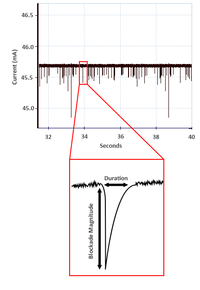Scanning ion occlusion sensing

Okay kiddo, you know how we can use our eyes or a camera to see things? Well, scientists want to see really, really small things that are smaller than our eyes can see or even what a microscope can see. That's where scanning ion occlusion sensing comes in.
Atoms are the smallest building blocks of everything around us, and sometimes scientists want to look at individual atoms or see what's inside them. Scanning ion occlusion sensing uses tiny electrically charged particles called ions to do this.
Imagine you have a toy house with a bunch of rooms inside. If you want to see what's inside each room, you can shine a flashlight into the windows. Scientists use ions as the "flashlight" and "rooms" are the tiny spaces between atoms. As the ions move through these spaces, they get blocked or slowed down by the atoms they encounter, and scientists can use this information to create a picture of what's inside.
But how do they see the ions? This is where things get really clever. Scientists use a tiny pipette, like a straw, to hold a liquid containing ions. They move the pipette close to what they want to see and create a small voltage difference that attracts the ions towards the object. As the ions move around and get blocked or slowed down, this can be detected and used to map the surface or inside of the object.
So, scanning ion occlusion sensing is a way for scientists to see incredibly small things by using charged particles and a special pipette that can "sense" those particles as they move around. It's kind of like looking inside a toy house with a flashlight, but for really, really tiny things!
Atoms are the smallest building blocks of everything around us, and sometimes scientists want to look at individual atoms or see what's inside them. Scanning ion occlusion sensing uses tiny electrically charged particles called ions to do this.
Imagine you have a toy house with a bunch of rooms inside. If you want to see what's inside each room, you can shine a flashlight into the windows. Scientists use ions as the "flashlight" and "rooms" are the tiny spaces between atoms. As the ions move through these spaces, they get blocked or slowed down by the atoms they encounter, and scientists can use this information to create a picture of what's inside.
But how do they see the ions? This is where things get really clever. Scientists use a tiny pipette, like a straw, to hold a liquid containing ions. They move the pipette close to what they want to see and create a small voltage difference that attracts the ions towards the object. As the ions move around and get blocked or slowed down, this can be detected and used to map the surface or inside of the object.
So, scanning ion occlusion sensing is a way for scientists to see incredibly small things by using charged particles and a special pipette that can "sense" those particles as they move around. It's kind of like looking inside a toy house with a flashlight, but for really, really tiny things!
